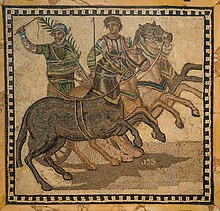Roman Culture/Chariot racing
Chariot racing was one of the most popular sports in Roman history. It was a sport that lots of Romans had fans and cheered like modern sports in today's world. According to PBS, it was held at "The Circus Maximus" which could hold 200000 people. It was said that there was a sculpture called "spina" to show the fans how many laps the racers had been finished.[1] Even though chariot races were not as brutal and violent as gladiator fighting, it was still one of the most dangerous sports in Roman history. Since it was a race, lots of racers wanted to make their overall weight (horse+ armor+ clothes+ chariot, etc) as light as possible. They were light and very durable against harsh attacks from other racers and accidents during races, and because of that, it led many racers and horse some serious injuries which often time led to even deaths. According to Oracle Thinkquest,"there was no set of official rules, but the first one to go around the stadium seven times won"[2] which made racers to attack each other and their horses as well during racing. In the chariot racing, there were teams that were divided as it says: "Chariots were organized in four main teams- Red, White, Blue, and Green"[1] and each team were supported by fans. Each team had scouts who encouraged getting a good rider and good horses[1] which made them very similar to the modern sports scouts to bring good players into the team.

Most of chariot racers did not have long career since this was such a dangerous sport. Accidents during the racing usually brought severe injuries and even deaths. Due to the heavy casualties, lots of racers either died during racing or retired early at young age with terrible injuries. However, there was a famous racer who avoided such casualty and had a long career. His name was Gaius Appuleius Diocles. According to Barbara F. McManus, it says that “He began driving for the Whites at the age of 18; after 6 years, he switched to the Greens for 3 years, and then drove 15 years for the Reds before retiring at the age of 42. He won 1,462 of the 4,257 four-horse races in which he competed, and his winnings totaled nearly 36 million sesterces. Diocles’ career was unusually long; many charioteers died quite young (Fuscus at 24, Crescens at 22, Aurelius Mollicius at 20).” (Barbara Mcmanus) which made him an unusual and special racer compared to others. This was something that most racers could not accomplish in such a dangerous sport.
Chariot races were usually popular among commoners and those who were wealthy (who are not in position of high class). A lot of people who were on the group of elites in Rome did not like chariot races due to the cruelty and deaths which applied almost same on gladiators as well. Even though lots of elite group insisted on banning the chariot races with gladiator, chariot racing survived long and it remained as one of the most popular entertainment sports in Roman history which brought lots of pleasures and emotions among fans.
References
editEDITED: by Ariel Turpin on 12/14/2011 Checked for formatting, spelling, grammar, and plagiarism.